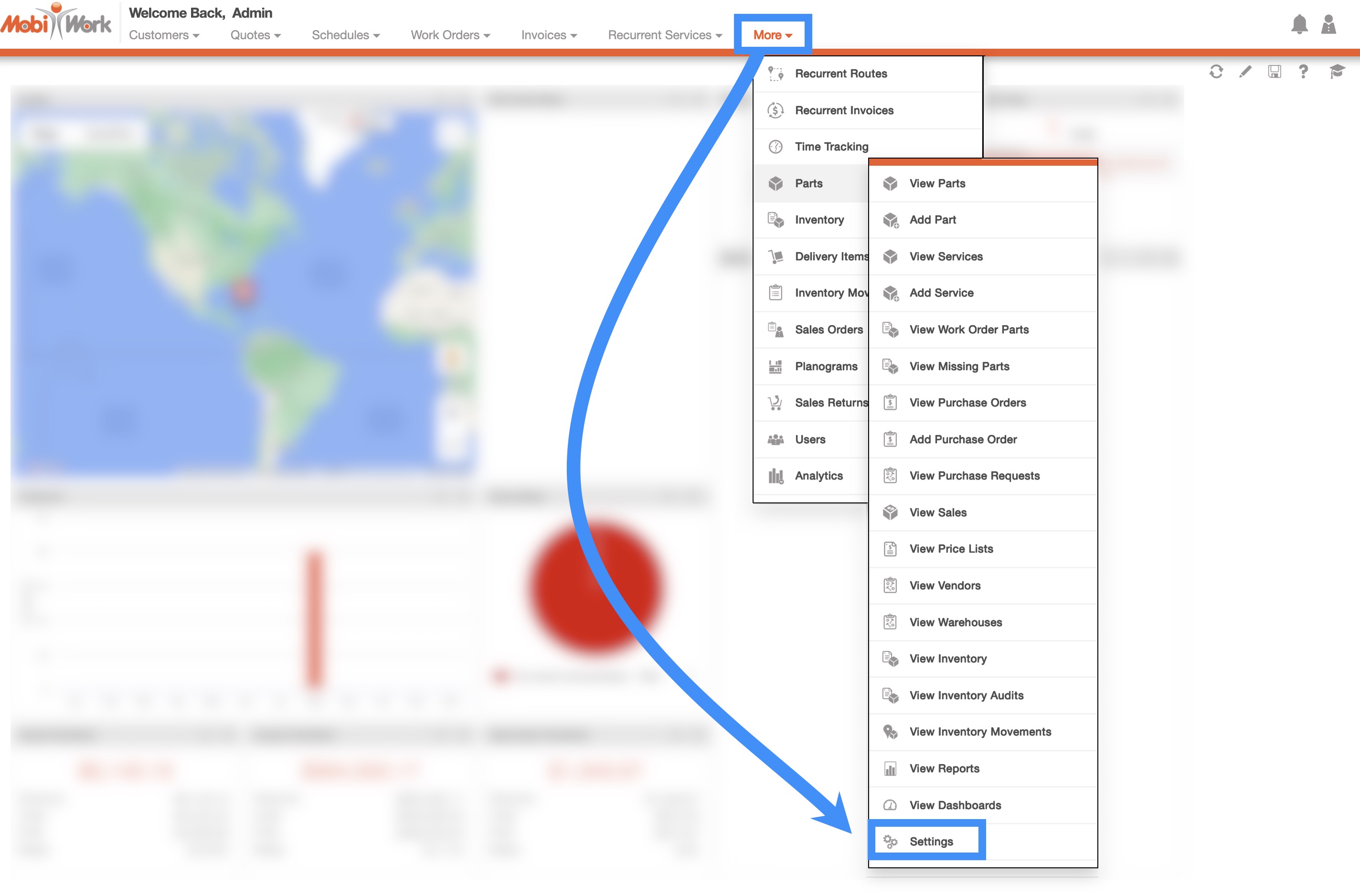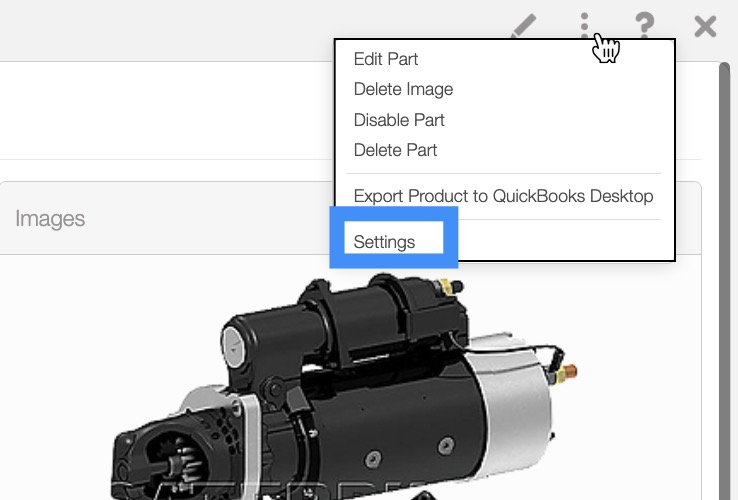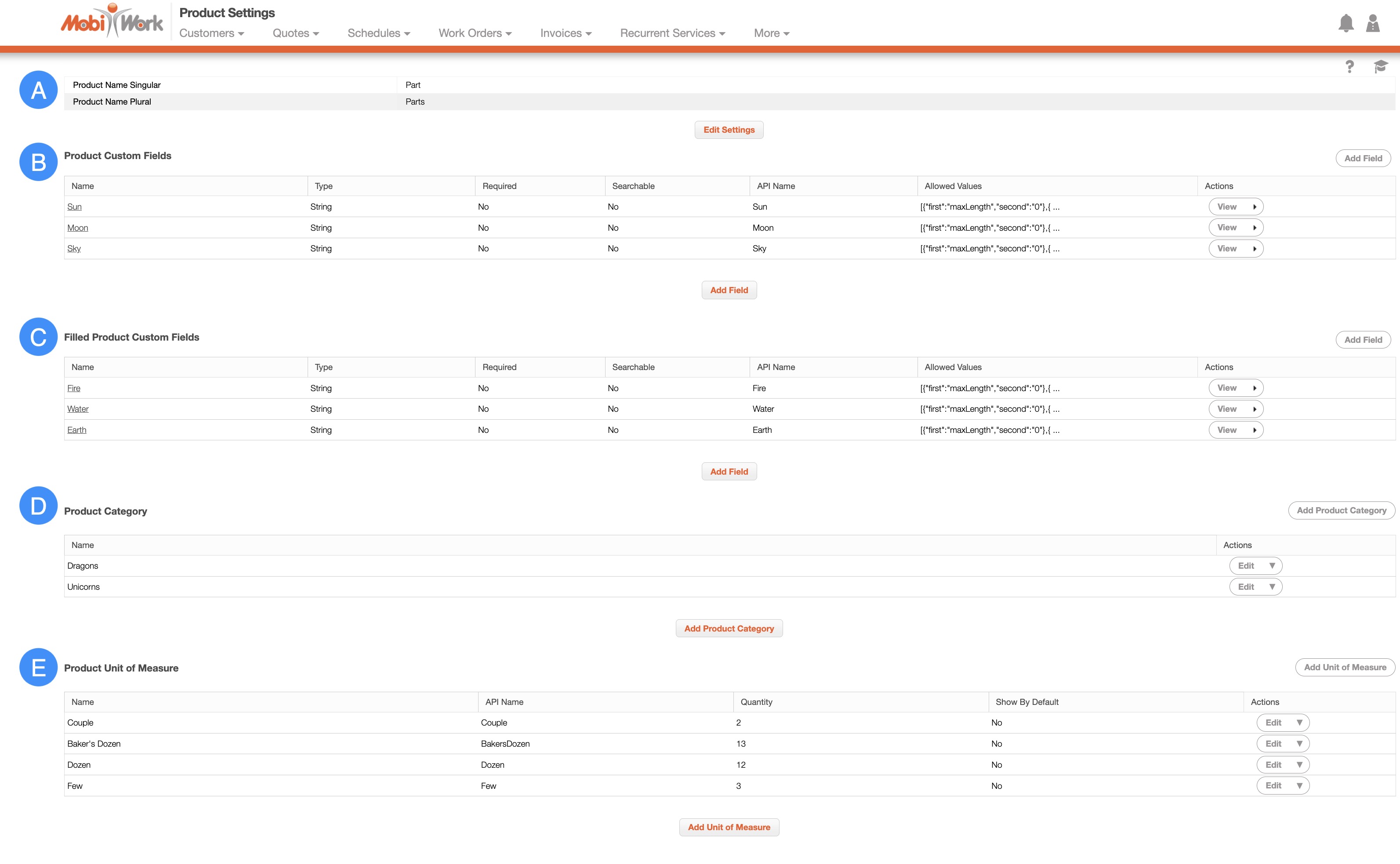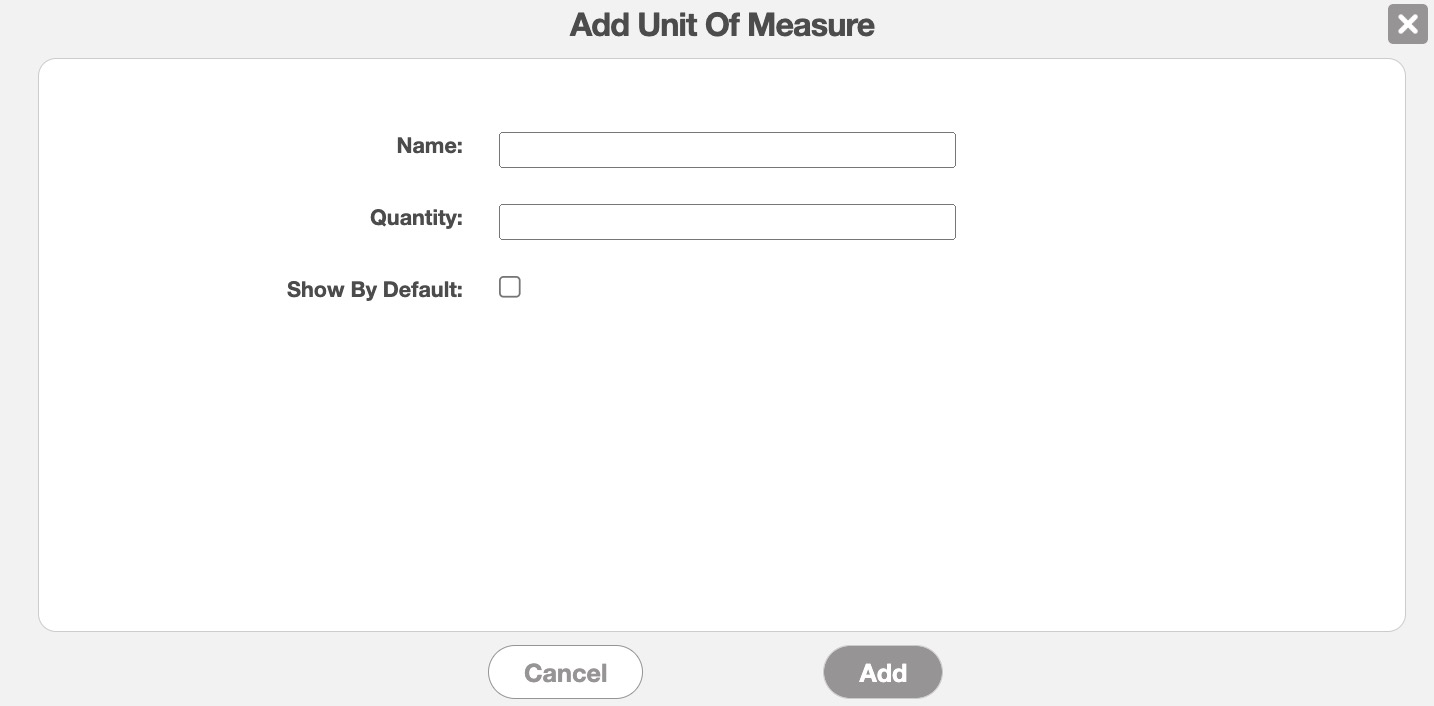- Overview
- Account Settings
- Assets
- Connectors Framework
- Overview
- QuickBooks Online
- QuickBooks Desktop Web Connector
- Azure AD
- Salesforce Integration
- FleetNet Connector
- Avalara Connector
- Inbound REST API
- Outbound REST API
- Mailchimp Connector
- Text Messaging Connector
- Clearent Connector
- Stripe Connector
- HubSpot Connector
- UKG Connector
- Paylocity Connector
- UKG Connector
- Gusto Connector
- iSolved Payroll Connector
- Customer Portal
- Customers
- Dashboards
- Devices
- Dispatching
- Forms
- Inventory
- Invoices & Billing
- Locations
- Payments
- Parts
- Projects
- Quotes
- Recurrent Routes
- Recurrent Services
- Reports
- Sales Orders
- Schedule
- Services
- Tasks
- Text Messaging
- Time Tracking
- Users
- Work Orders
On the Parts Settings page you will be able to add or edit custom fields, categories, and even create a Product Unit of Measure, which will allow you to define the number of parts or services being sold at once.
This section will expound on how to utilize the features found on the Parts Settings page so you will be able to create categories, fields, etc. that can be implemented on your parts and services.
There are several different ways you can access the Parts Settings page:
You can directly access the Parts Settings page by selecting the Parts feature from MobiWork, and clicking on the "Settings" option:
From the Parts feature page, there are two different ways you can access the Parts Settings page. For more information on how to access the Parts List tab please see the Parts List (Catalog) page:
- By clicking on the ID and accessing the View Part pop-up window. From the Individual Actions drop-down select the "Settings" option:
By clicking on the More Actions button located at the top-right of the Parts Catalog and from the drop-down select the "Settings" option.



Once you are on the Parts Settings page there will be a number of different sections:

The "Parts Settings" section will display both the singular and plural versions of how you refer to your MobiWork parts and services (e.g., product / products, stock / stocks, etc.):

You can update the term by clicking on the Edit Settings button and then entering the desired part terms:

Once you are satisfied with the new term, click the Save button.
The "Custom Fields" section will allow you to add additional fields for your users. These fields will appear when you add, edit, view, or import/export your users.
The custom fields that you add can be searchable, appear once, be open ended, be required or optional, or can be visible or hidden to the customer:

The list of terms found in the "Custom Fields" section are defined below:
| Name: | Description: |
|---|---|
| "Name" | The name of the custom field. |
| "Type" | The type of custom field which include string, number, decimal, date, yes/no, multiple choice, QR code, signature, header, image capture, notes, phone number, phone number plus extension, SSN, time field, text area, vertical separator, vertical spacing, multiple QR code, customer field, product field, user field, project field, asset field, store field, dynamic header, and multiple option dropdown. |
| "Required" | Indicates if the custom field is required to fill or not. |
| "Searchable" | If checked, the custom field will become searchable within the New Search pop-up window. (It will not be searchable in the Free Text Search bar). |
| "API Name" | The API name of the custom field. It is used in the Reporting section and configuring PDFs. It does not change after it is created. |
| "Allowed Values" | Shows the configuration information; only provides value during troubleshooting. |
| "Actions" | Will allow you to view, edit, or delete the selected custom field. |

Once you are satisfied with the parameters of the new field, click the Add button to finalize.
The terms found when you add a new custom field are defined below:
| Name: | Description: |
|---|---|
| "Property Name" | The name of the custom field. |
| "Property Type" | is the type of custom field which include string, number, decimal, date, yes/no, multiple choice, QR code, signature, header, image capture, notes, phone number, phone number plus extension, SSN, time field, text area, vertical separator, vertical spacing, multiple QR code, customer field, product field, user field, project field, asset field, store field, dynamic header, and multiple option dropdown. |
| "String" | is a field where the user can enter text. The field supports limiting the number of characters that can be entered. |
| "Number" | is a number field that does not accept decimals. The maximum and minimum number for the field can be defined. |
| "Decimal" | is a number field that accepts decimals. The maximum and minimum number for the field can be defined. |
| "Date" | is a field that allows the selection of the date from a pop-up calendar or a 3-field layout. It can be specified whether the current date will automatically appear and cannot be edited. |
| "Yes/No" | is a yes/no field indicated by a checkbox. |
| "Multiple Choice" | is a multiple-choice field where the values within it can be specified within "Select Values" by placing a comma between each value. You can indicate if the first value is invalid. For instance, if in the first value you want to give instructions for the multiple choice such as, "Please select from the following:" |
| "QR Code" | is a field that captures barcode/QR code data (only for the device). |
| "Signature" | is a signature capture field to capture signatures (only for the device). |
| "Header" | is a bold label that does not allow input. |
| "Image Capture" | is an image capturing field that displays in the mobile device that allows photos to be taken to upload into the field or uploads existing images from the mobile device's gallery into the field. It can be specified to not allow images from the device gallery. |
| "Notes" | adds notes to the notes list for the entity. For example, if a form is filled for a work order, then the note field content will be added to the work order notes list. |
| "Phone Number" | is a phone number field that can be indicated if the phone number will appear in one or three fields. |
| "Phone Number Plus Extension" | is a phone number field that allows for an extension to be entered. It can be indicated if the phone number plus extension will appear in one or four fields. |
| "SSN" | allows the inputting of the social security number within 3 fields (###-##-#### format). |
| "Time Field" | Allows you to specify a 12- or 24-hour time format |
| "Text Area" | is a larger text field for multiple sentences, notes, etc. |
| "Vertical Separator" | is a vertical line separator for the web only. |
| "Vertical Spacing" | places spacing between rows for the web only. |
| "Multiple QR Code" | allows the scanning and inputting of multiple QR codes continuously in this field. |
| "Customer Field" | allows the selection of the customers available in the Permissions to appear in the field. |
| "Product Field" | allows the selection of the products available in the Permissions to appear in the field. |
| "User Field" | allows the selection of the users available in the Permissions to appear in this field. Default to device user, if selected, will display the user who is logged in on the device within the field. |
| "Project Field" | allows the selection of the projects available in the Permissions to appear in the field. |
| "Asset Field" | allows the selection of the assets available in the Permissions to appear in the field. Associate asset with work order, if selected, and if a custom field or form is associated to a work order then it will associate the asset with the work order. |
| "Store Field" | allows the selection of the stores available in the Permissions to appear in the field. |
| "Dynamic Header" | allows you to show data from the associated work order or customer (such as work order description, customer's name, etc.). |
| "Multiple Option Dropdown" | is a drop down where you can select multiple options. |
| "Required" | Indicates if the custom field is required to fill or not. |
| "Searchable" | If checked, the custom field will become searchable within the New Search pop-up window. (It will not be searchable in the Free Text Search bar) |
| "Customer Visible" | will allow customers to view the form field on the Customer Portal. |
| "Number of Times" | include once which will show the form field one time or multiple open-ended which will add the form field multiple times. |
| "Device Read Only" | means the field cannot be edited on the device. |
| "Web Read Only" | means the field cannot be edited on the web. |
| "Long Question Type" | is for the label of the field. It is a user interface setting which gives more space for the label on the device. |
| "Field Description" | are any comments that describe the field. |
| "Show Advanced Options" | include QuickBooks Field Name, Label CSS, and Initial Value for this Field. |
| "QuickBooks Field Name" | only applies to customer forms/custom fields. This refers to the name of the corresponding field in QuickBooks which is used during the import/sync. |
| "Label CSS" | is a web only feature which allows the entered HTML CSS attributes to be applied to the field label (for example, showing the label of the field in red with a font size of 20 px). |
| "Initial Value for this Field" | sets the initial value of this field when the form is added/opened on the device. At present, this needs to be configured by MobiWork's Professional Services team. |
The "Filled Product Custom Fields" section is almost identical to the "Product Custom Fields" section; the one distinction between the two sections is that, when adding custom fields in the "Filled Product Custom Fields" section, the filled product custom fields are shown/added when a product is added to a product field:

To add a new filled product custom field, click the Add button. The Add Field webpage will then be identical to the one in the "Product Custom Fields" section.
The "Product Category" section will allow you to categorize your parts and services into specific classifications (e.g., hand tools, safety gear, etc.):

To add a new product category, click the Add button. You will then be redirected to the Add Product Category page where you can input the name of your new category:

The terms found in the "Product Categories" section are defined below:
| Name: | Description: |
|---|---|
| "Name" | The name of the product category |
| "Actions" | Will allow you to edit or delete the product category |
The "Product Unit of Measure" section is where you would add "Group Words" to MobiWork. These "Group Words" are used to define the number of parts or services being sold at once. (e.g., two items can be called a duo, and twelve items can be called a dozen).
A separate barcode is used for these group orders and can be specified when added to the product (the quantity will then be adjusted if needed). When this barcode is scanned, the system will automatically know the quantity you are referring to:

To add a new unit of measure, click on the Add Unit of Measure button and the Add Unit of Measure pop-up window will appear:

In this pop-up window input the:
Name of the grouping.
The number of parts in a grouping.
And the checkbox to indicate if the grouping should show by default.
Once you are satisfied with the new unit of measure, click the Add button.
The terms found in the "Product Unit of Measure" section are defined below:
| Name: | Description: |
|---|---|
| "Name" | The name of the product of measure (grouping word) |
| "API Name" | The API name of the product of measure; it is used in the Reporting section and configuring PDFs. It does not change after it is created. |
| "Quantity" | The set number of parts included in the product of measure (the grouping) |
| "Show by Default" | If the product unit of measure will show by default |
| "Actions" | Will allow you to edit or delete the product of measure |
If you have any questions or need further assistance, please let us know. We'd be happy to help!
